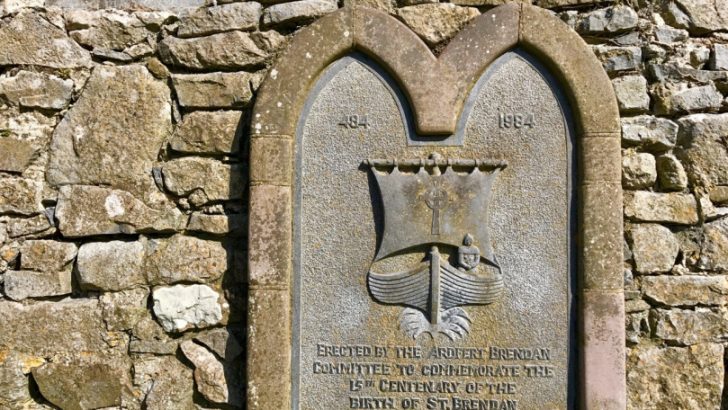Summer outings (No.5 in a six-part series)
Today Richard Hayward’s long series of books, over seven of them, all dealing with his journeys into the four provinces and into the mind and imaginations of his countrymen, north and south, are out of print and long forgotten.
An Ulster man of many parts, he died in 1964. In writing his circuit of Kerry 20 years before, it was inevitable that Hayward should have something to say about St Brendan – Brendan the Navigator, as he was called by Dr George Little in another Irish book published, by chance, in 1945.
Dr Little was intent on exploring the seafaring ways of the Kerry saint, along the west coast of Ireland, through the remote and misty Northern islands, and on to…wherever it was that the “promised land of the saints” was found by the saint and his family of monks.
Dr Little showed that for the voyage to that land across the ocean, according to Irish legend, he used not any kind of curragh, but a sturdy wooden ship of which he had a model made by John Featherstone.
Holy places
Mount Brandon is one of the holy places of Ireland, a huge monster of a mountain, over 3,000 feet high and eight miles long from Brandon Point to that defile near Ballybrack which we saw from Kilmalkedar.
Five miles wide it is from Brandon Head to the Owenmore River and known by its present name only since the 7th Century, up till which time it was called Sliabh Diadche.
St Brendan founded a monastery here in the middle of the 6th Century and the fame of his settlement was to give his name to the mountain for evermore and to make the place one of holy pilgrimage.
He founded several monasteries…and evangelised many districts in Brittany, England, Scotland and the Western Isles”
May 16 is St Brendan’s Day and it is on that day the pilgrims climb to the summit, where the little oratory of the saint still stands, and perform the rounds of the penitential stations which lie just below it.
Two altars are there also and many ruined clochauns which were associated with the ancient foundation.
But the greatest pilgrimage of modern times took place on June 28, in the year 1868, when over 20,000 pilgrims gathered under the guidance of the great Dr Moriarty and literally covered the immense crown of the sacred hill in their devotional exercises.
***
St Brendan was born near Tralee in the year 483 and was buried 94 years later in his most celebrated foundation, the Celtic Monastery of Clonfert in the County Galway.
He was baptised by St Ere, the spiritual father of all the saints of Kerry, at the Wether’s Well near Ardfert, and drew up a monastic rule which survived until the Anglo-Norman invasion, but which is now lost.
He founded several monasteries apart from those of Clonfert, Brandon and Ardfert, and evangelised many districts in Brittany, England, Scotland and the Western Isles, but perhaps his chief fame now centres in the Navigatio Sancti Brendani, a wonder tale that seems to have been on the shelves of every monastic and secular library in Europe long before the invention of printing.
A French version of this celebrated work was made by an Anglo-Norman bard before English versification had been introduced by Robert of Leicester, Gower and Chaucer, and from this translation a wider currency than ever was given to the amazing exploits of the Irish saint.
From St Brendan’s description of the unknown land in which he dwelt for several years, later scholars asserted that it was America, and it is significant that the early Scandinavian voyagers knew America as Irland It Mikla and that Lief Erikson, who lived in Massachusetts long before Christopher Columbus was born, spoke of legends and strange stories that were told in that far land about “an Irish man of God and of the sea” and about “the promised land of Brendan”.
Guidance
The Arabian geographer, Abdullah Mohammed Edrisi, wrote a book in the 12th Century in which he referred to Irland It Mikla as ‘Great Ireland’, which recalls the fact that many of the very strange happenings set down by St Brendan are almost exact parallels of similar adventures in The Arabian Nights.
It is recorded that Brendan had been praying for some days on the summit of Brandon, seeking heavenly guidance to those Isles of the Blest which he believed lay out on the rim of the western ocean, when the Angel of the Lord appeared and directed him in the details of this voyage which was to bring him the title of The Navigator.
He was about 60 years of age at the time and was absent from Ireland for seven years, his little fleet consisting of “three vessels ribbed within, covered with the hides of oxen tanned with oak-bark, with the joints tarred and food in plenty for 70 days” – in other words, of three curraghs, frail craft indeed to brave the stormy hazards of an Atlantic crossing.
And if the whole story is inextricably mixed up with folklore and legend and was compiled centuries after the death of St Brendan, it is unlikely that it is not based in some way on actual happenings and that the title of Navigator was not well earned.
It is an interesting footnote that Iceland was visited by Irish missionaries before the time of the Norsemen and that many Irish personal names still persist in that northern land.
Edited from In the Kingdom of Kerry, by Richard Hayward, drawings by Theo. J. Gracey (Dundalk: William Tempest, 1945).


 Peter Costello
Peter Costello

